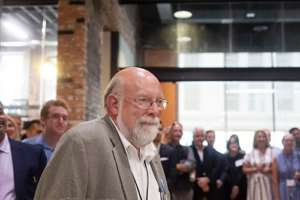This website uses cookies
We use cookies to ensure that we give you the best experience on our website. If you continue to use this site we will assume that you are happy with it.
Within five years of the founding of the Legal Information Institute (LII), more people were visiting the online resource than had attended Cornell Law School in its entire history. The first internet site to provide free access to legal information, the groundbreaking LII has been directed by Tom Bruce from its inception to his retirement this year. On June 4, in Washington, D.C., friends and colleagues gathered to, as Bruce put it, break a bottle of champagne over his head and send him down the slipway.

Tom Bruce.
Bruce joined the Law School in 1988 as the director of education technologies. In 1992, along with then-dean Peter Martin, he founded the LII. Bruce wrote much of the original software used at the Institute, including Cello, the first Web browser for Microsoft Windows.
Speaking at the retirement celebration, Eduardo M. Peñalver, Allan R. Tessler Dean and Professor of Law, noted, “I think Tom knows this about me: I like to mark time in Whitesnake years. So 1988 is . . . the second year of Whitesnake; that was the year they released their second huge hit —I’m sure you all know —‘Is This Love?’”
He added, “I also like to mark gradations of success in terms of Whitesnake . . . I’ll come back to [that].”
“Cornell and LII have been very fortunate to have Tom at the helm of LII for its first twenty-five years,” said Peñalver. “LII has thrived under his leadership, growing from the simple idea of free access to legal information for all people into a powerhouse that delivers free legal information to millions of people around the world. At the time LII began, there were only 22 million users on the Internet worldwide. These days, it’s visited by over 30 million users every year from over 200 countries.”
Peñalver noted that incoming co-directors Sara Frug and Craig Newton would be building on the firm foundation established by Bruce—and aided by LII’s first endowment, a fellowship created in Bruce’s honor with generous support from Justia.
“And where will Tom be while Sara and Craig and the fellows are steering LII through the shoals of innovation in a fast-moving world of legal tech? He will be enjoying his retirement, secure in his knowledge that—unlike most of us—[he] really is bigger than Whitesnake. Whitesnake’s greatest triumph, the 1987 hit ‘Here I Go Again,’ has been viewed on YouTube a mere 56 million times over the past ten years. In that same period, LII has lapped Whitesnake four times over.”
In his own remarks, Bruce drew parallels between his tenure at LII and his previous work as a stage manager (though not for Whitesnake), noting of the Institute, “[I]n the end, what has made it rewarding is what it does for other people. That makes it an awful lot like putting on a big show that reaches an audience of millions, and I have been a stage manager for that, just as I worked on other, much shorter-running shows in my first career, including, God help me, one called ‘Got Tu Go Disco.’”
Bruce’s theater experience, he said, fueled his collaborations first with Martin and more recently with his successors. “[C]ollaboration has continued to be the secret sauce that has made us successful in building a big web site. But that was never the hardest or largest part of the work.”
The hardest part, he said, was establishing and maintaining the creative and innovative conditions under which the work of LII could be done. “[T]hat is what I am the second-most-proud of having done for the last twenty-seven years.”
“I am most proud,” he continued, “of the way in which we have managed the transition. I have extraordinary successors . . . This is the most talented and capable roster that we have ever had.”
As for his own future plans, Bruce said that he has “started to organize unusual noises into something that can occasionally claim to be music.” At this point, he broke out a ukulele, and mentioning a few upcoming live and radio performances—as well as, of course, some collaborations—he played himself off.
Following this musical interlude, Frug and Newton shared some remarks, as well as a video compilation of messages from scholars around the world who had collaborated with Bruce. These far-flung colleagues expressed their appreciation, admiration, and affection for the trailblazer with whom they have worked to make the law accessible to all.